If you love the tangy flavor from fermented foods you are going to love this homemade red cabbage sauerkraut.
Lacto-fermented with just water and salt, this colorful tangy condiment is bursting with health-promoting beneficial bacteria good for the gut.
Learn how to make your own red sauerkraut with this simple method and never buy an expensive jar from the health food store again!
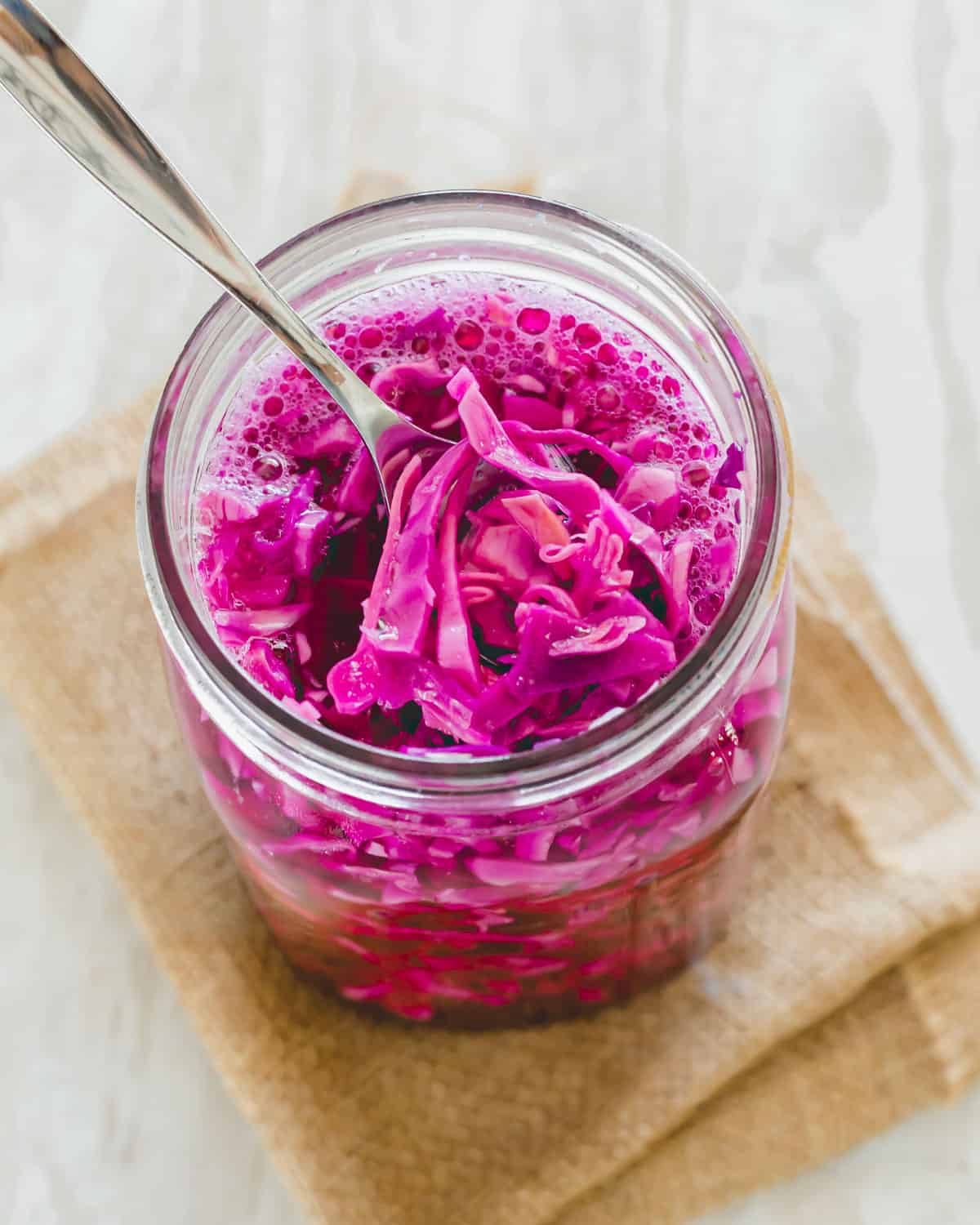
I’ve long been a sauerkraut and mustard person when it comes to my hot dogs. The thought of ketchup on a hot dog truly grosses me out.
But, that’s not even why I decided to start making my own sauerkraut lately.
For me, it’s all about the amazing benefits of fermented foods, which of course, sauerkraut is.
Way back in the day when I first started experimenting with homemade ferments, I wrote this post about how to ferment vegetables.
It’s funny what becomes popular on a recipe site with over 1,000 recipes 10 years later but that post is consistently one of the top 5 every single year.
I was into the process for awhile but if we’re being honest, had fallen off the bandwagon for the last few years and found myself buying $8+ jars of sauerkraut or kimchi from a local company instead.
A couple of weeks ago, however, I finally got fed up with the money I was spending buying sauerkraut knowing just how easy it is to do it myself.
So, here we are with the simplest way to make homemade red cabbage sauerkraut.
This recipe will walk you through exactly what’s needed, the process of lacto-fermentation (sounds complicated, I promise it’s not) and even give you some delicious ways to enjoy the fruits of your labor.
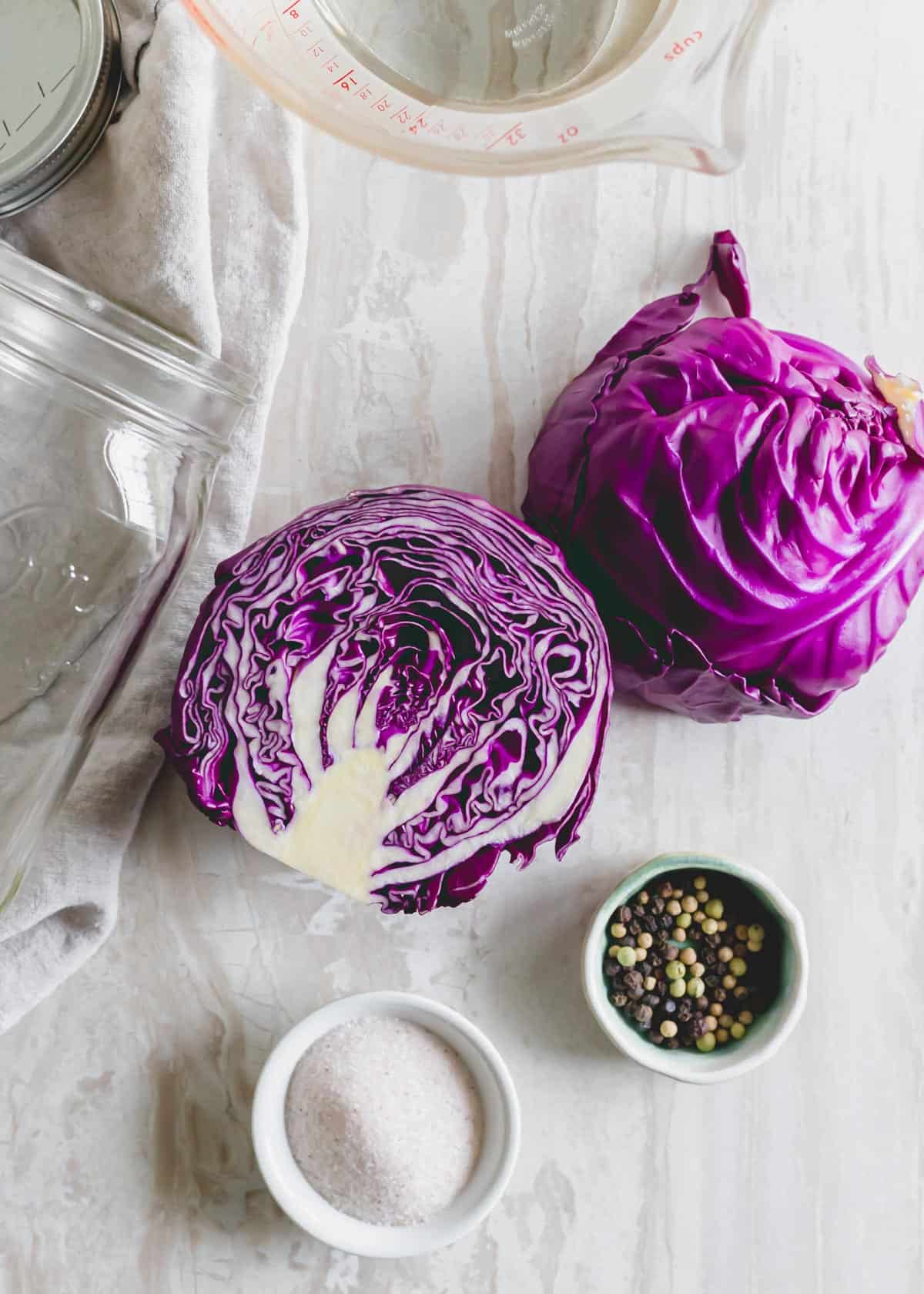
INGREDIENTS TO MAKE RED CABBAGE SAUERKRAUT
Don’t blink because there’s not much needed at all to make fermented sauerkraut!
- red cabbage, thinly shredded
- filtered water
- sea salt (I like Redmond’s mineral sea salt for this)
- peppercorns (optional)
- 32 oz. wide mouth mason jar with regular metal screw on lid
Optional equipment:
- burp lids (also known as fermentation lids)
- fermentation weights
This fermenting supplies list actually details the top 10 helpful tools and gadgets to make the process both easier and safer.
-
Buy Now$21.99
We earn a commission if you make a purchase, at no additional cost to you.
07/18/2025 07:05 pm GMT -
Buy Now
$15.95$14.99We earn a commission if you make a purchase, at no additional cost to you.
07/18/2025 08:02 pm GMT -
Buy Now$21.96
We earn a commission if you make a purchase, at no additional cost to you.
07/18/2025 07:04 pm GMT -
Buy Now$15.89
We earn a commission if you make a purchase, at no additional cost to you.
07/18/2025 08:05 pm GMT -
Buy Now$59.89
We earn a commission if you make a purchase, at no additional cost to you.
07/18/2025 07:05 pm GMT -
-
Buy Now
$19.99$18.99We earn a commission if you make a purchase, at no additional cost to you.
07/18/2025 07:05 pm GMT -
-
$12.99Buy Now
Using a quick-read thermometer takes the guess work out of cooking meat in the air fryer, oven or grill.
07/18/2025 08:02 pm GMT -
Buy Now
$26.95$21.99We earn a commission if you make a purchase, at no additional cost to you.
07/18/2025 08:05 pm GMT
But don’t be deterred if you have none of it. Fermenting food at home can be done with just the basics. These tools are purely for convenience. I didn’t start out with anything other than a glass jar and I don’t always use fancy equipment when fermenting.
RED CABBAGE VS. GREEN CABBAGE
If you prefer green cabbage or only have that type on hand, this recipe can absolutely be made the same way with green cabbage. You can even use previously frozen cabbage although the texture will be a little softer than fresh.
CHOOSING THE RIGHT WATER AND SALT
The ingredients to make fermented foods through lacto-fermentation processes such as this are incredibly simple: water and salt.
That said, they both need to be of high quality.
The water used should also be free of chlorination or filtered.
If you have city tap water at your home, make sure to use filtered water as it often contains chlorine, fluoride and trace amounts of other potentially toxic components.
The salt should be pure sea salt or Kosher salt. Choose a high quality salt without any additives.
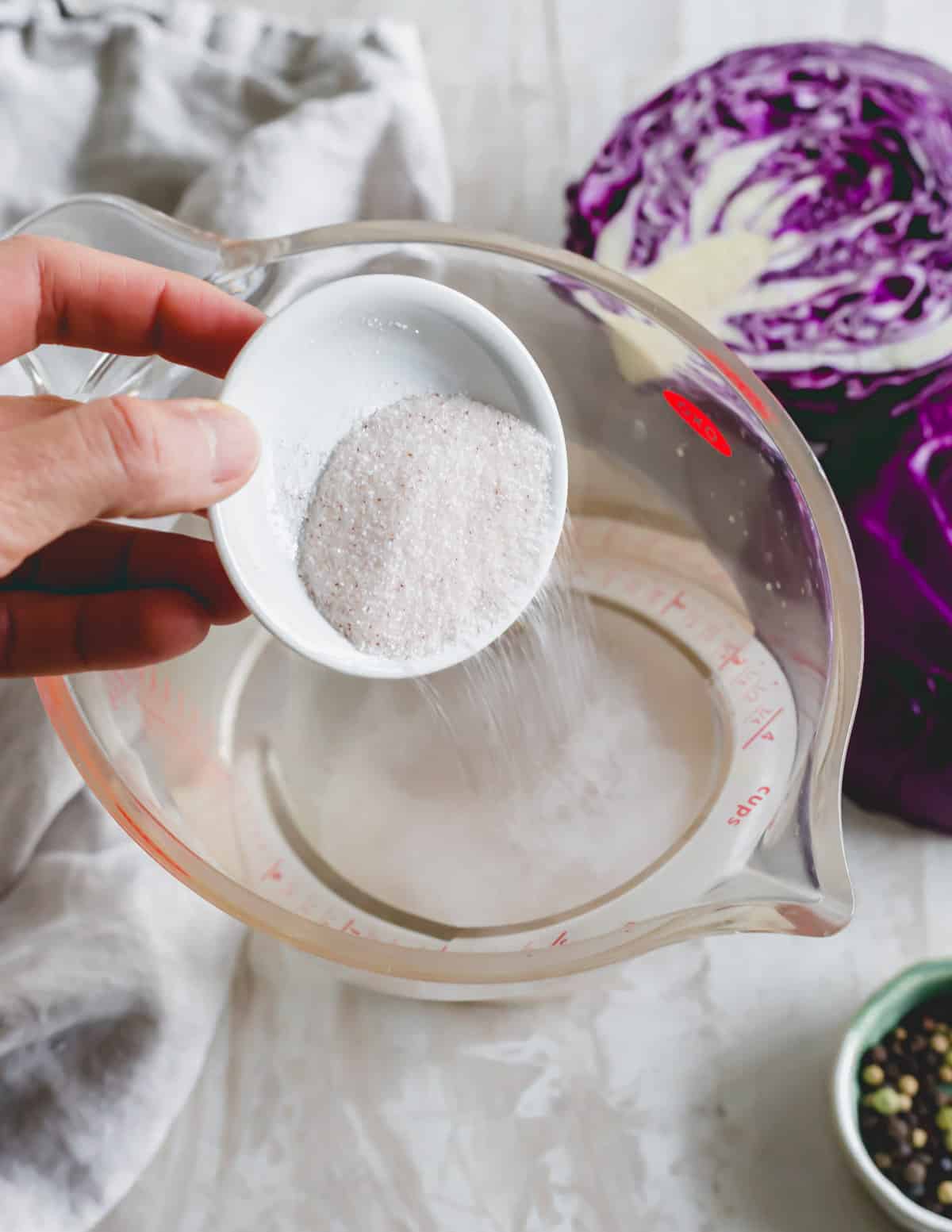
HOW TO MAKE FERMENTED RED CABBAGE
Start by sterilizing a wide mouth mason jar. To do this, place the jar in a large stock pot and bring to a boil. Let the jar boil in the water for 10 minutes. Remove with tongs to a kitchen towel and let dry.
The sterilization process is important, don’t skip this step otherwise you risk introducing unwanted bacteria to the fermentation.
Combine filtered water and sea salt in a measuring cup. Stir until the salt is fully dissolved.
Slice the red cabbage to your liking. Usually, sauerkraut is very thinly sliced. You can do this by hand with a very sharp knife or a box grater. Alternatively, use a food processor with a shredding disc attachment to make the process easier.
If using peppercorns, place them in the bottom of the mason jar.
Fill the jar to the top with the shredded red cabbage, leaving about 1/2″ of space at the top.
Pour the salt and water mixture on top of the cabbage until it’s fully covered. Make sure to leave 1/2″ space at the top of the jar.
At this point, if you have a fermentation weight, you would place it on top of the cabbage to keep it fully submerged in the brine.
If you don’t have a weight, a small dish turned upside down that fits in the jar works just as well.
I’ve made sauerkraut without using either. You just need to make sure the cabbage stays submerged in the liquid. If it has access to air, mold can form.
Screw the lid on and place the jar on the counter at room temperature out of direct sunlight.
BURPING THE SAUERKRAUT
As the cabbage starts to ferment, it will create gasses. This is a a good thing!
The gasses and bubbles are indicative of the beneficial bacteria doing exactly what they’re supposed to do – proliferate.
These gasses need to be released periodically, however, otherwise they can build up and create an explosion.
This is where burping comes in. If you’re using a regular metal mason jar lid, you’ll need to gently and carefully loosen it to let the gasses escape 1-2x per day.
If you’re using a specially designed burping lid, there’s no need to do this as those lids are designed to slowly let the gasses escape without the need to “burp”.
I find the gas build up to be the most between days 2-5. It’s not a bad idea to place the jar on a small plate to catch any liquid that may spill over when you burp it.
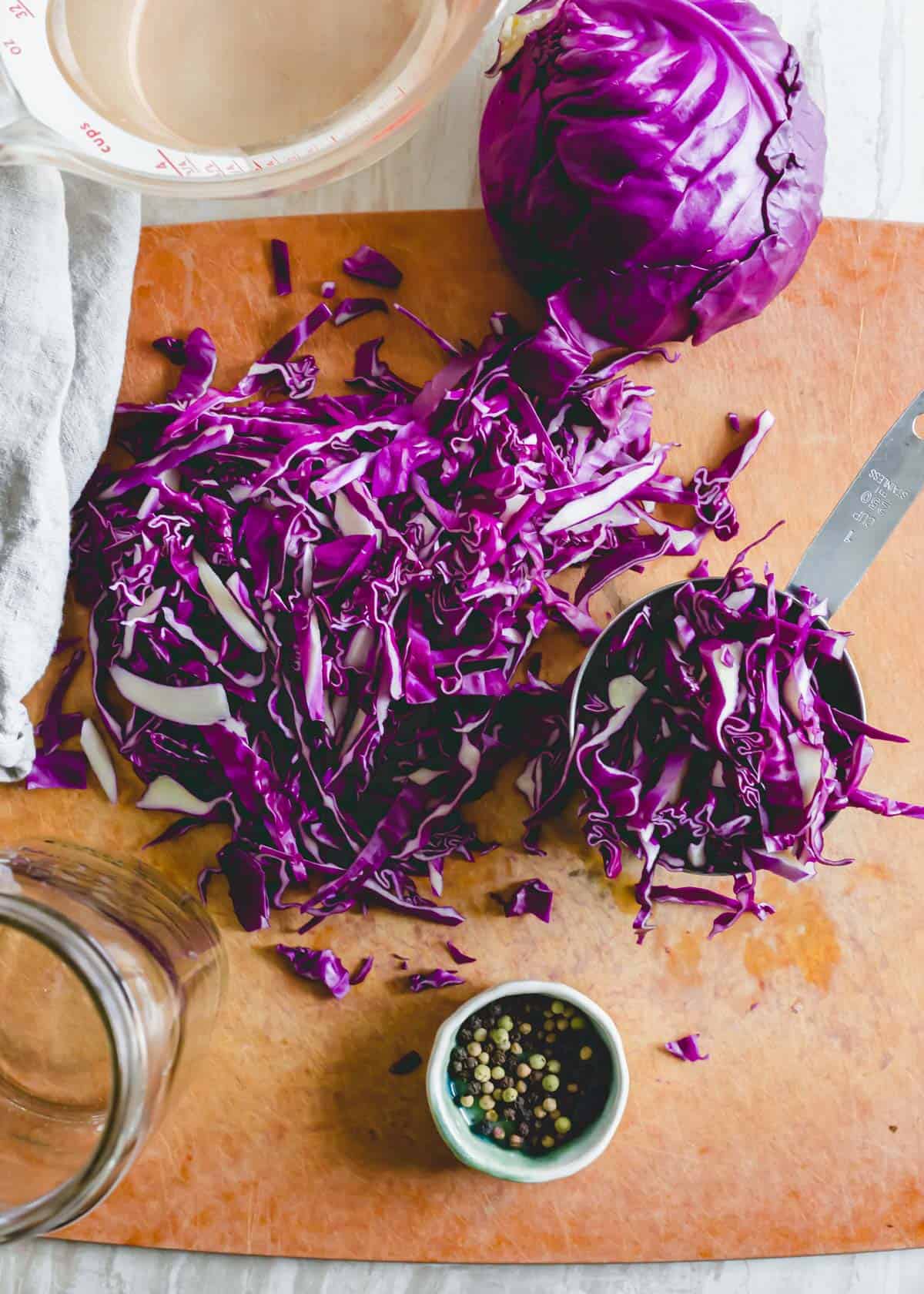
HOW LONG DOES IT TAKE TO MAKE SAUERKRAUT?
The red cabbage sauerkraut will take about 7-10 days to ferment appropriately at room temperature.
Start tasting the sauerkraut around day 6 or 7 and assess its tanginess. I typically let mine go for a minimum of 8 days.
The length of the fermentation is really one of personal preference though. It can easily be left for longer if you desire a very tangy kraut. Some sauerkraut aficionados brag about leaving their ferment out for up to 4 weeks!
HOW TO STORE FERMENTED CABBAGE
Once the red sauerkraut has fermented to your liking at room temperature, transfer the mason jar to the refrigerator and keep it stored there for up to a month or so.
Once you see all the delicious ways to incorporate red cabbage sauerkraut into your meals though, it won’t last long at all!
SHOULD I WASH CABBAGE BEFORE MAKING SAUERKRAUT?
No!
It’s actually very important not to wash the cabbage before making sauerkraut. The fermentation process relies on the natural bacteria found on the cabbage leaves to properly ferment. You can, however, peel the outer leaves to get rid of any dirt and wilted parts of the vegetable.
ADDING FLAVORINGS TO SAUERKRAUT
Once you get this base recipe and method down, I highly recommend playing around with added spices and flavorings to customize your sauerkraut!
If you’ve seen the boutique krauts and kimchi popping up in stores you’ll see many varieties from more traditional flavors like caraway and cumin seeds to ginger, turmeric and beet.
Pick and choose added spices, herbs and flavors based on what appeals to you and add them to the jar first before adding the shredded cabbage.
I personally love fresh turmeric, garlic, peppercorns and some caraway or fennel seeds in mine!
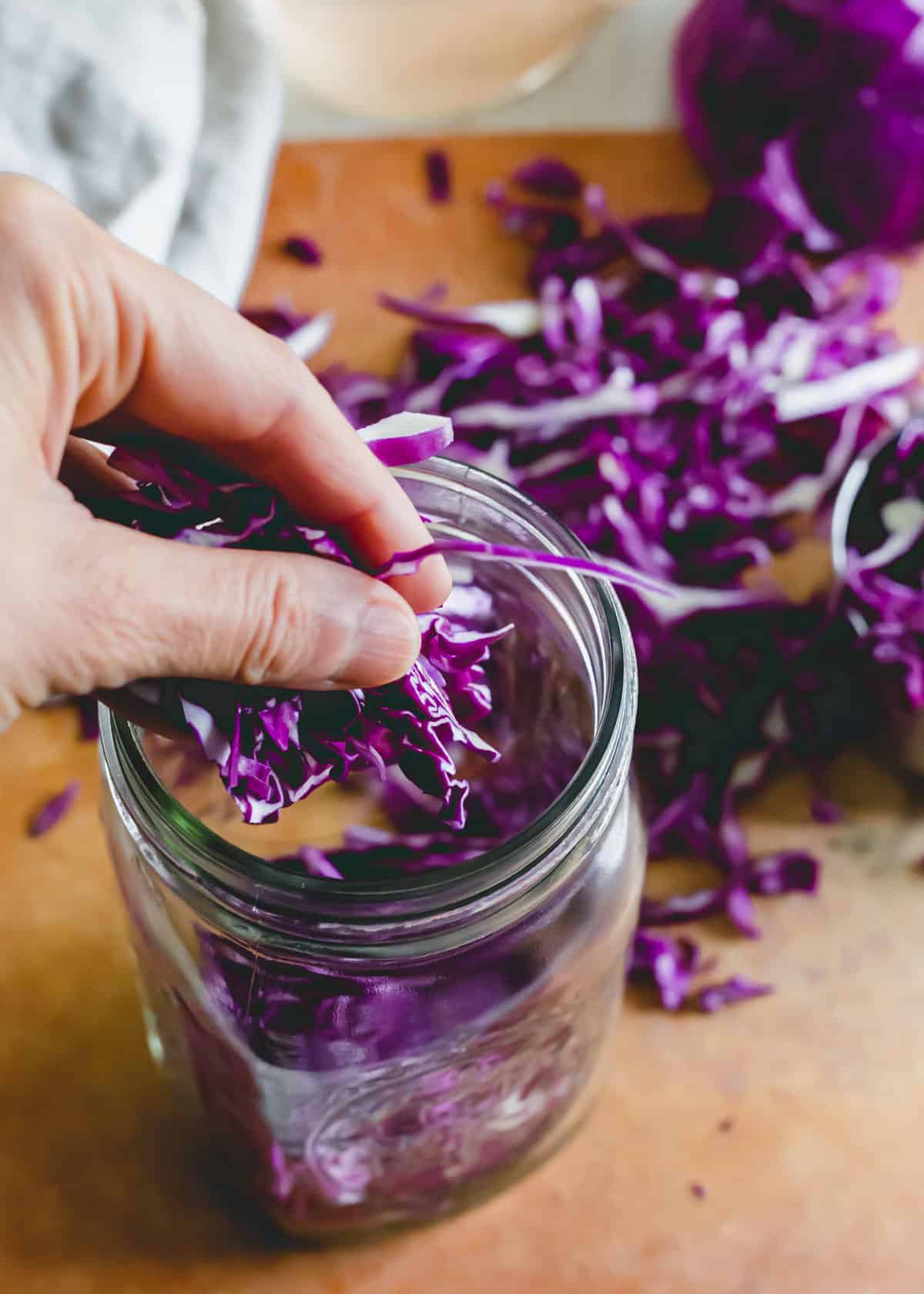
WHAT DOES FERMENTING SAUERKRAUT LOOK LIKE?
I get it, it’s probably pretty unnerving to set a jar of vegetables in some salt water on your countertop for over a week and just leave it be!
It goes against everything we’ve been “taught” about keeping things safely under refrigeration.
But, that’s exactly the environment the beneficial bacteria naturally found on the cabbage itself need to grow and thrive and facilitate the fermentation process to create sauerkraut.
When fermenting properly, you’ll see tiny bubbles at first forming on the sides of the jar and rising to the top. The bubbles will increase in size as the fermentation continues and eventually, when you loosen the lid to burp the kraut, they’ll have accumulated at the top of the jar.
SHOULD RED CABBAGE KRAUT SMELL WHILE FERMENTING?
If you’ve ever eaten sauerkraut you know it’s a pungent smell!
Therefore, don’t be alarmed if as the days go on, the fermenting red cabbage starts to take on that same intense cabbage/sauerkraut smell. It’s natural!
WHAT TO DO IF MOLD FORMS IN THE JAR
Mold can happen from time to time when fermenting foods if the proper environment isn’t kept.
Mold needs air to grow which is why it’s so important to keep the red cabbage fully submerged in the salt water brine.
If you identify mold on your ferment, it’s best to throw it out and start fresh. This post has some great information on troubleshooting mold in fermentations and tips to avoid it in the future.
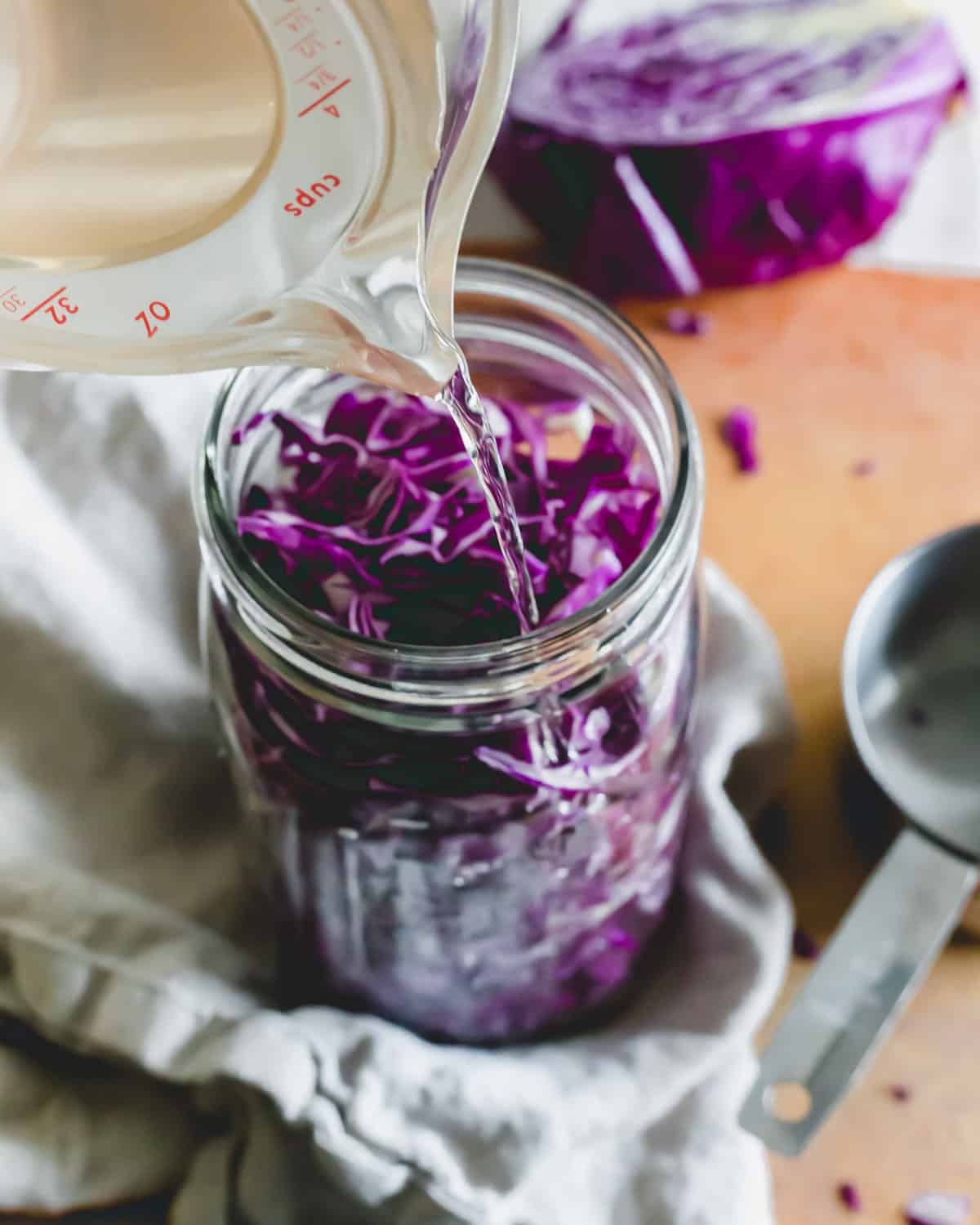
IS PICKLED RED CABBAGE THE SAME AS SAUERKRAUT?
While both pickling and fermenting produce the same tangy flavor, they are not the same.
Don’t get me wrong, I love a good pickled ingredient.
From pickled pineapple to pickled garlic scapes to even just plain old spicy garlic dill pickles, pickling has a time and place.
In fact, even red cabbage like this can be quick pickled for things like tacos when you need a tangy component in a hurry.
Here’s a great simple pickled cabbage recipe to check out!
Fermented red cabbage or sauerkraut as we’re calling it here, however, is a totally different process despite producing a similar flavor in the end.
Pickling simply combines water, vinegar and usually sugar with whatever ingredient you’re using (onions, radishes, or other vegetables and fruit, etc.) to quickly create a tangy flavored component for meals.
Fermented foods, rely on a natural process of bacteria to breakdown the sugars found on the foods being fermented. This is the process true sauerkraut undergoes, not pickling.
LACTO-FERMENTED RED CABBAGE SAUERKRAUT
This process of fermentation (also called lacto-fermentation) is two fold: first, it wipes out any detrimental bacteria which are killed off by the salty environment and then, it allows the beneficial bacteria — known as probiotics — to take over because they can tolerate the salty brine.
These good bacteria which are in the Lactobacillus family, convert the sugars naturally found on fruits and vegetables into lactic acid.
Lactic acid is a natural preservative that helps fight off bad bacteria while simultaneously preserving the flavor, texture and nutrients of the food.
FERMENTING VS. CANNING
Another mistake often made is confusing fermenting with canning. Lacto-fermentation is not the same thing as canning and not intended for long-term storage like canning is mainly used for.
Most fermented foods store for 1-2 months and the flavors deepen and acidify as they sits. Canning is intended to preserve a food in its current state for long periods of time.
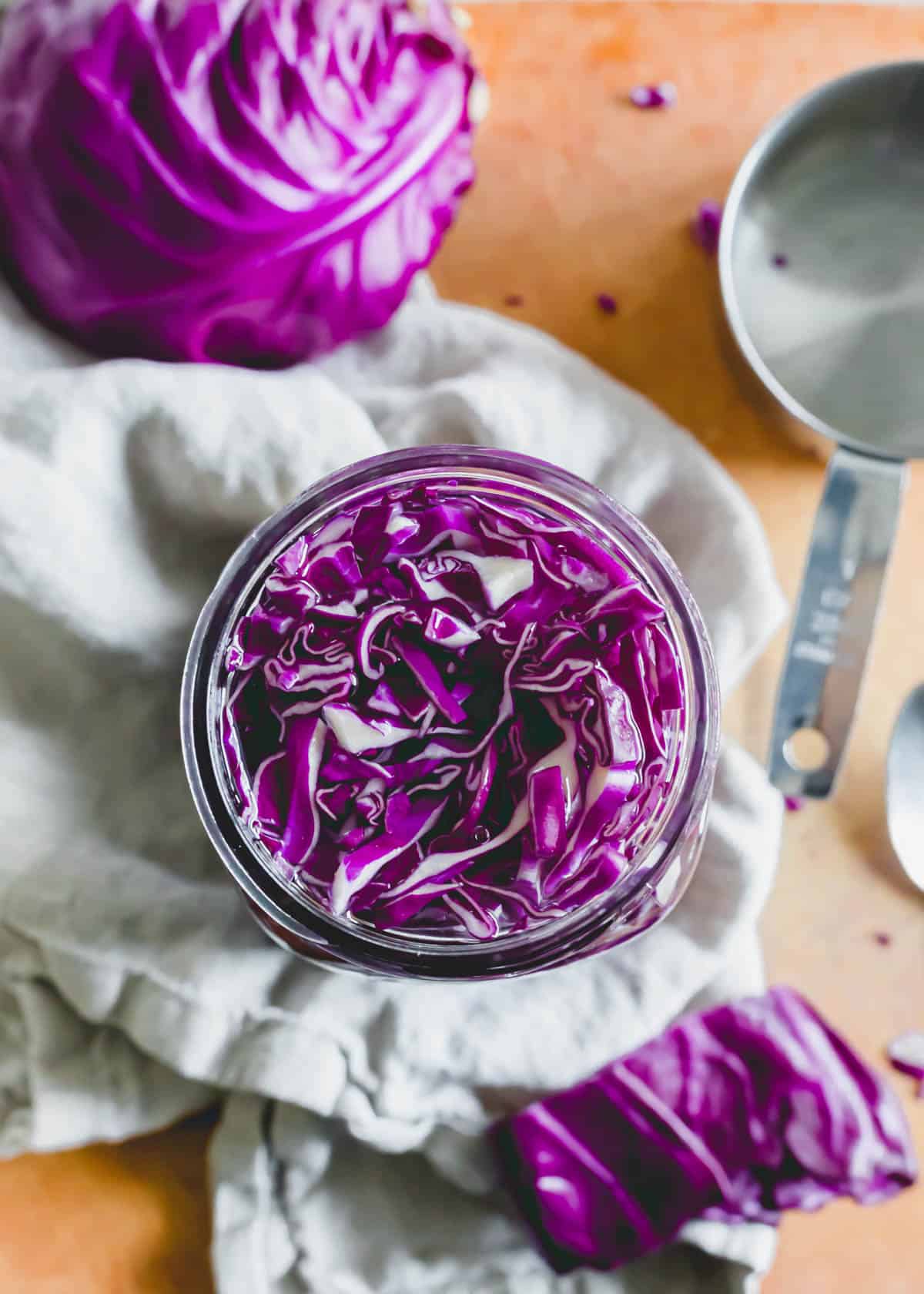
IS PURPLE CABBAGE SAUERKRAUT GOOD FOR YOU?
Phew, that was a lot on the process and methodology, let’s get to the good stuff now – what are the benefits of eating sauerkraut?
Naturally fermented sauerkraut, whether red cabbage or green cabbage, is incredibly nutritious and healthy!
The probiotics (aka beneficial bacteria) produced in the fermentation have been shown to be associated with improved digestion, gut health and immune health.
Looking to improve your gut health? Try this gut healing smoothie recipe!
Sauerkraut is also high in fiber and vitamin C.
If you’ve heard the term “eat the rainbow” lately, it’s for good reason. Different colors when it comes to plants are indicative of increased levels of polyphenols in a plant.
For example, the deep color of red or purple cabbage is due to the high levels of anthocyanin, a type of polyphenol associated with antioxidant and anti-inflammatory benefits.
It’s the same polyphenol in tart cherries – a fruit I love so much and often use in recipes like this sheet pan turmeric salmon with tart cherry sauce and these tart cherry gummies for sleep.
It’s for this reason I choose to make red cabbage sauerkraut instead of green cabbage sauerkraut.
The red variety of the cabbage family also has double the amount of iron, 10 times the amount of vitamin A and significantly more vitamin C.
Regular green cabbage sauerkraut is still delicious but with the increased health-generating capacity of red cabbage, it’s a no brainer to make this variety.
NATURALLY FERMENTED SAUERKRAUT VS. STORE-BOUGHT
It’s important to make this one last distinction about sauerkraut.
You may be asking yourself why going through this process is even worthwhile when you can just pick up a can of shelf-stable sauerkraut in the grocery store?
Well, like most things in life, the easy way out is not necessarily the better.
Store-bought shelf-stable sauerkraut is not the same as fermented sauerkraut like this recipe.
Simply said, canned store-bought varieties go through the pasteurization process therefore eliminating all the healthy live probiotics created in the fermentation process.
So while it may taste the same and have that tangy flavor you love about sauerkraut, it contains hardly any of the same health benefits as naturally homemade fermented red cabbage sauerkraut.
Refrigerated fermented krauts, kimchi or other foods like tempeh do, however, usually still contain the beneficial bacteria. It’s only the shelf-stable products which do not.
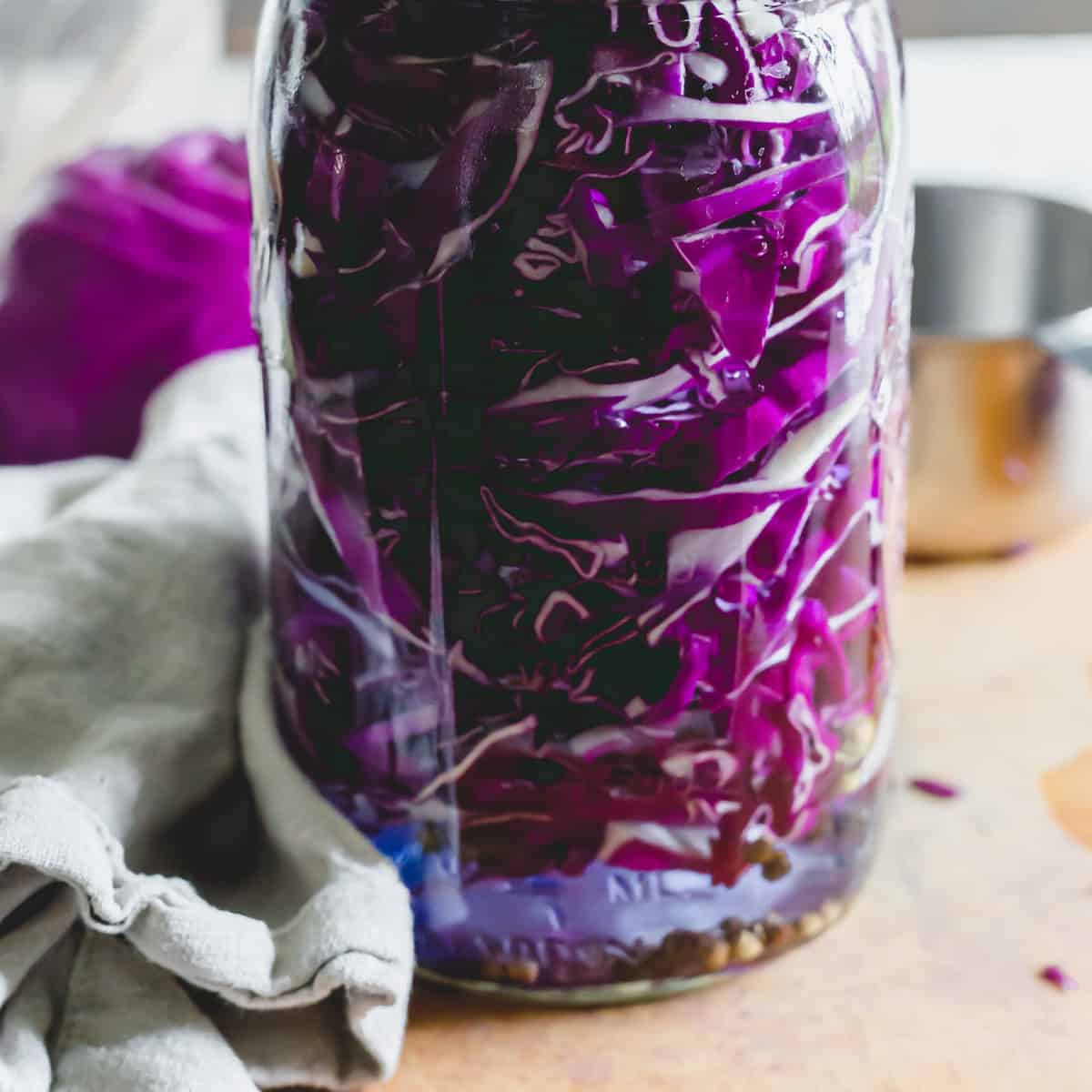
HOW TO EAT RED CABBAGE SAUERKRAUT
Besides the obvious “on top of a hot dog!” answer, there are many ways to serve and enjoy sauerkraut.
For a slight step above a hot dog, I love it on an easily prepared air fryer sausage or brat made in the air fryer.
But beyond the traditional American or German uses of pairing with meats, sauerkraut is a wonderful condiment on sandwiches, wraps and salads.
I love it on an open-faced sardine salad sandwich or dijon dill salmon salad for lunches. It’s also great as a burger topping. Try some on this beet and beef burger, a juicy elk burger or in a burger in a bowl.
For snacking, enjoy it on avocado toast, hummus toast or even dolloped in the center of a bowl of hummus and enjoyed with some crackers.
Instead of pickled components, use it in tacos like these delicious lamb tacos, quesadillas, nachos (they’d be great on these spring lamb nachos) or stuffed potatoes. Paired with brisket in these brisket nachos or brisket quesadilla it’s phenomenal. Its bright tangy flavor balances out the savory meat so well.
I even use it as a topper in a variety of soups and stews.
Honestly, almost any meal can be improved by a tangy spoonful of red cabbage sauerkraut. The possibilities are endless!
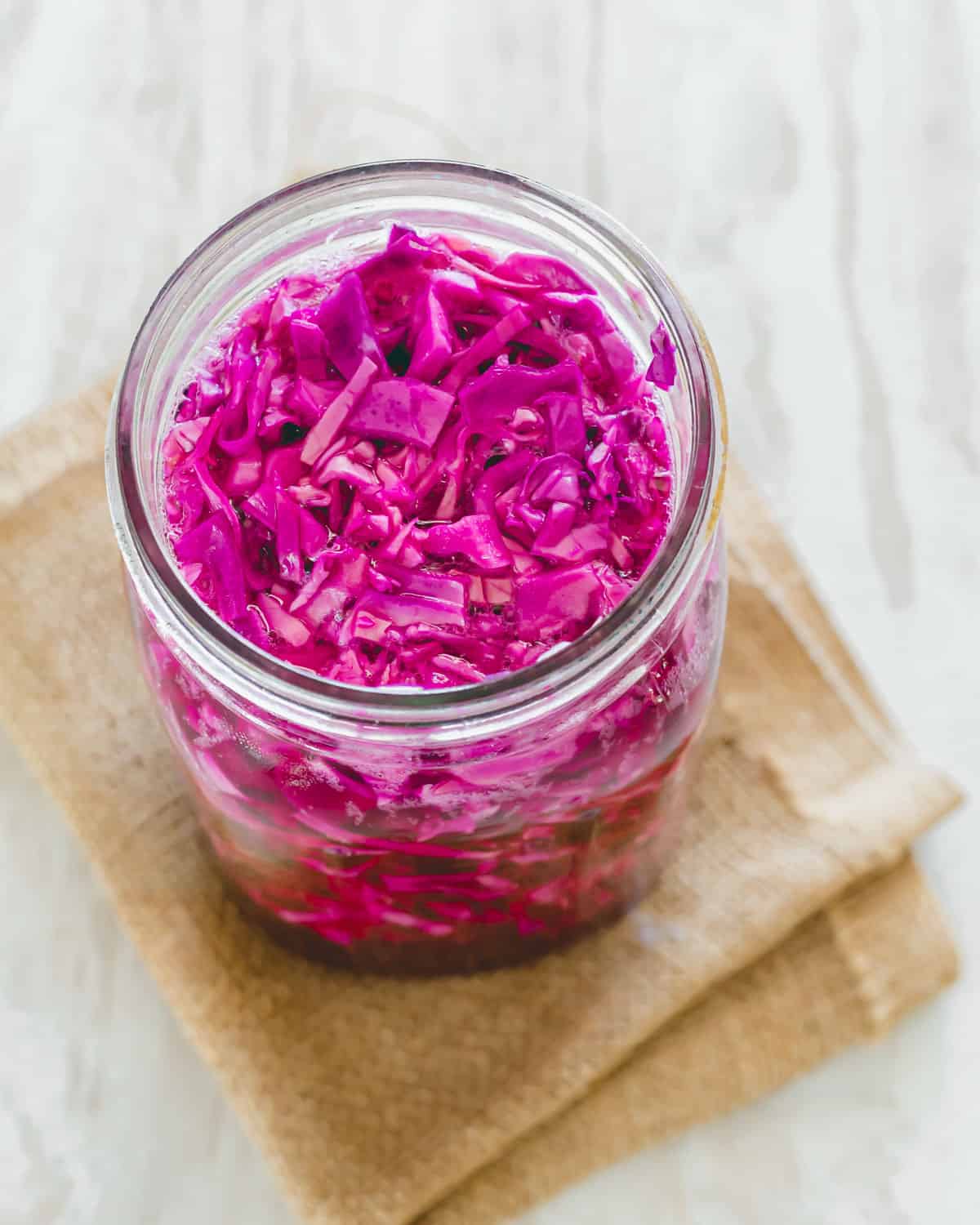
TIPS AND TRICKS FOR THE BEST SAUERKRAUT
Here are a few things to keep in mind for a successful ferment:
- Use Enough Salt – don’t be alarmed if the salt water brine seems very salty. The salt is necessary to get rid of the initial “bad” bacteria.
- Keep the Cabbage Submerged! – keeping the cabbage away from oxygen will inhibit any mold growth as well as create the anaerobic environment needed for the good bacteria to do their thing.
- Patience – waiting out the 7-10 ferment period can be hard for the impatient but a necessary skill when dealing with lacto fermented vegetables like sauerkraut. The longer the kraut stays out at room temperature, the more tangy and fermented it will taste!
LIKE THIS SAUERKRAUT RECIPE? TRY THESE TOO:
Pickled Cranberries
Creamy Cucumber Salad with Pickled Red Onions
Chilled Mango Melon Soup with Pickled Cucumber
Pickled Fennel Citrus Salad
Red Cabbage Sauerkraut (Fermented Red Cabbage)
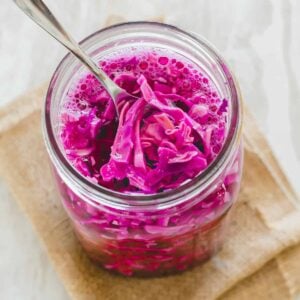
Equipment
Ingredients
- 3 cups shredded red cabbage, *see note
- 3 cups filtered water
- 1 1/2 tablespoons unrefined mineral sea salt
- 1/2 tablespoons peppercorns, optional
Instructions
- Sterilize a 32 ounce wide mouth glass mason jar and set aside.
- Stir the salt and water together in a measuring cup until salt is fully dissolved.
- Place the peppercorns (if using) in the bottom of the sterilized jar then top with the shredded red cabbage leaving about 1/2" of space at the top of the jar.
- Pour the brine solution into the jar until covering the cabbage.
- Top with the fermentation weight or a small dish to make sure the cabbage stays completely submerged in the brine.
- Screw on lid (regular lid or burp lid) and place on the counter out of direct sunlight.
- If using a regular metal screw on lid, carefully and gently release the built up pressure 1-2x per day to let the gasses escape. Bubbles on the top and sides are normal, this is indicative of a successful fermentation process.
- Sauerkraut is done when fermented to your liking. I typically let it go for a minimum of 7 days and up to 10 days. Start tasting after day 5 or 6 to assess the level of tanginess achieved. Once opened and consumed, transfer to the refrigerator and store for up to 3-4 weeks.
Notes
Nutrition
Nutrition information is automatically calculated, so should only be used as an approximation.
Gina Matsoukas is an AP syndicated writer. She is the founder, photographer and recipe developer of Running to the Kitchen — a food website focused on providing healthy, wholesome recipes using fresh and seasonal ingredients. Her work has been featured in numerous media outlets both digital and print, including MSN, Huffington post, Buzzfeed, Women’s Health and Food Network.

![Wide Mouth Mason Jars 32 oz [4 Pack]](https://m.media-amazon.com/images/I/51tqoHt7NFL._SL500_.jpg)





















Simplicityitself. If I had to add anything it would be NE add a little GLUCOSEb to the brine because the SUGAR CONTENT of the base ingredients can be very variable Number TWO. to kick start fermentation a add a little JUICE from arevious batch.
But always rwemember that any On_Line recipe is onlyone persons iteration of the basics so EXPERIMENT Making Sauerkraut must be one of THE easiest and cheapest kitchenn persuits there is.
The other practice I would most definitely recommend is to go down the PERCENTAGES route insteqd of the American Practice of CUPS SPOONS etc, that nobody else uses , It save mistakes and the MAGIC PERCENTQGE is 2.5 Additive Free Salt by weight of bothnCABBAGE and BRINE thogh slightly either way is b not critical. It you like alittle MORE acidity try adding a small amountof GLUCOSE to the brine . It can also speed things up to use a little @JUICE’ from a prvious batch inn the brine as well One final point, Fermentation is limited to the amount of SUGARS in the original material it doe NOT go on ad infinitum
How much salt?!
The exact measurements are in the recipe card at the bottom.
I love this recipe! It illuminates some of the problems that I have had in the last year or so.
[The part of the process that has become very hard for me over the years is the pounding of the cabbage to “bruise” it.
Also, it was recommended somewhere to use a very large jar and that makes it take quite a while, and it is harder to find weights that work. ]
Your articles are so clear and easy to understand. Thank you!
This went perfectly with hamburgers and hotdogs at our weekend cookout. Everyone loved the taste and the vibrant color.